4 simple Japanese seasonings to make at home
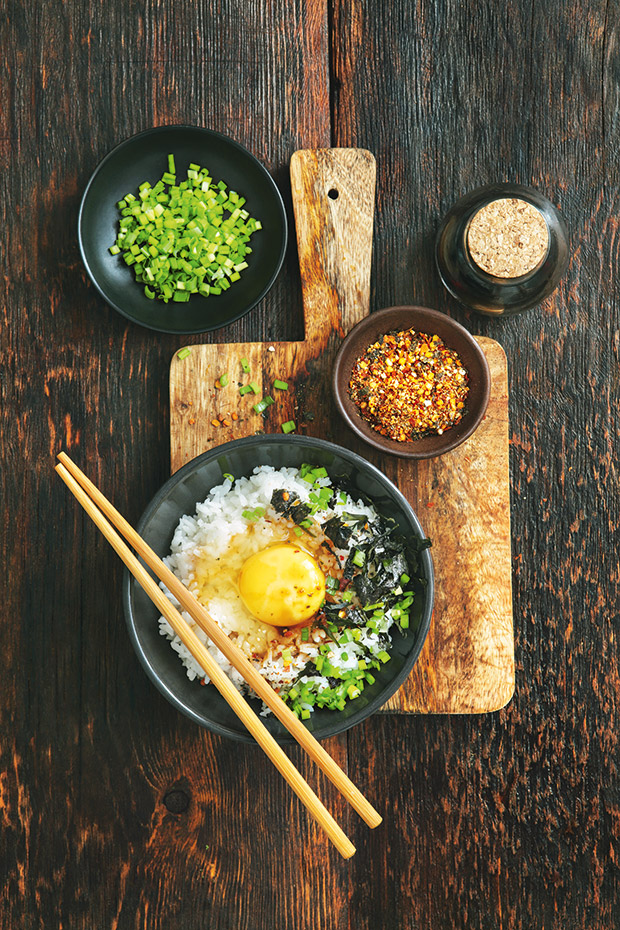
Traditional Japanese spice mixes are easy to make, and add sparkle to dishes from any culture.
Words: Jane Wrigglesworth
I’ve developed an enormous appreciation for Japanese cuisine since I started hosting Japanese students in a homestay initiative. My last student was a budding chef, here to study New Zealand food.
I passed on my knowledge of Kiwi dishes, and she taught me a great deal about Japanese cooking. This included several spicy condiments she often added instead of just plain salt and pepper. For example, she would season plain rice with salty, nutty, peppery furikake.
If you read the back of a shop-bought packet of furikake (pronounced foo-ree-car-keh), you’ll find ingredients such as garlic, red pepper, sesame seed, salt, onion, fish sauce, chicken, chicken fat, soy sauce, egg, and whey powder.
My student chef shared her homemade mixes with me. I’ve slightly adjusted her recipes, using ingredients more commonly found in NZ.
1. Furikake
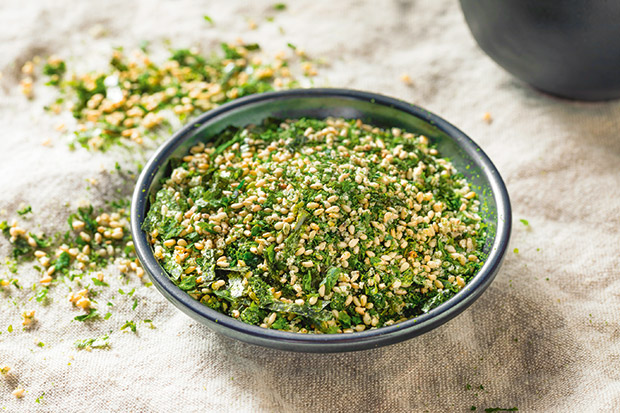
This can be moist or dry and comes in many flavours, including:
• wasabi (or horseradish) furikake;
• nori furikake (with shredded nori seaweed);
• shiso furikake (with the dried red leaves of shiso, Perilla frutescens);
• salmon furikake (fried salmon flakes).
It may also contain sesame seeds, bonito fish flakes, blue or green seaweed, nuts, cheese, and dried, crumbed omelette, depending on
which version you make.
How to use: Furikake is typically sprinkled over rice. It can be used in sushi or rice balls, omelettes or scrambled eggs, with pasta, or as a flavouring for popcorn. I make up a big batch and keep it in an airtight container for a quick flavour boost to a lot of my cooking. Use short grain rice which goes sticky when cooked, so furikake sprinkled on top won’t fall off as you eat it.
This is a great base spice. You can use it as is (below) or add extra ingredients. Options: powdered shitake, wasabi powder, kelp powder, miso powder, dried shiso leaves.
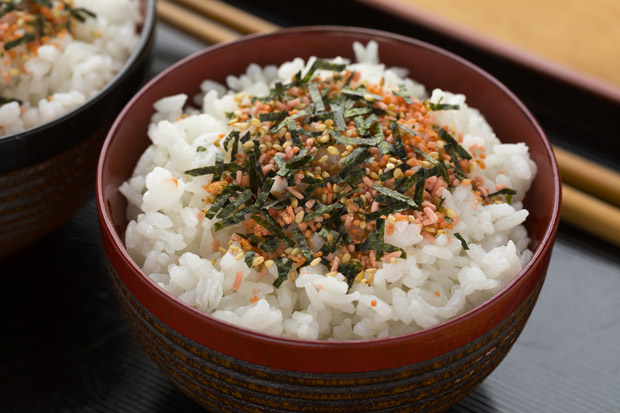
INGREDIENTS
¼ cup white sesame seeds
2 tbsp black sesame seeds
2 tbsp bonito flakes
1 tsp salt
1 tsp sugar
2 nori sheets, finely shredded
METHOD
Dry toast sesame seeds in a frying pan over a low heat until lightly browned. Allow to cool. Add remaining ingredients, and any optional extras. Store in an airtight container.
2. Nut & Spice Furikake
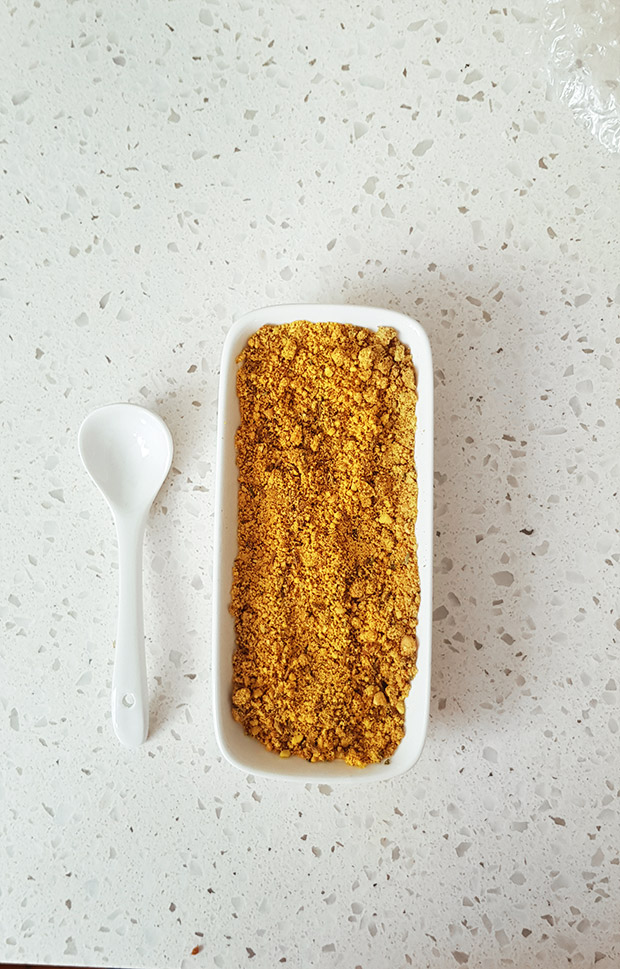
This very flavourful mix is used in many types of dish. It’s fairly salty, so you may want to use less than the one teaspoon of salt in this recipe.
INGREDIENTS
150g mixed raw nuts
1½ tbsp cumin seed
1 tsp ground turmeric
1 tsp ground coriander
1 tsp paprika
1 tsp garlic powder
1 tsp dried parsley
1 tsp salt
METHOD
Dry roast or toast nuts until lightly browned. Allow to cool. Place the nuts and the remaining ingredients in a food processor and blitz until it’s a powder.
3. Salmon Furikake
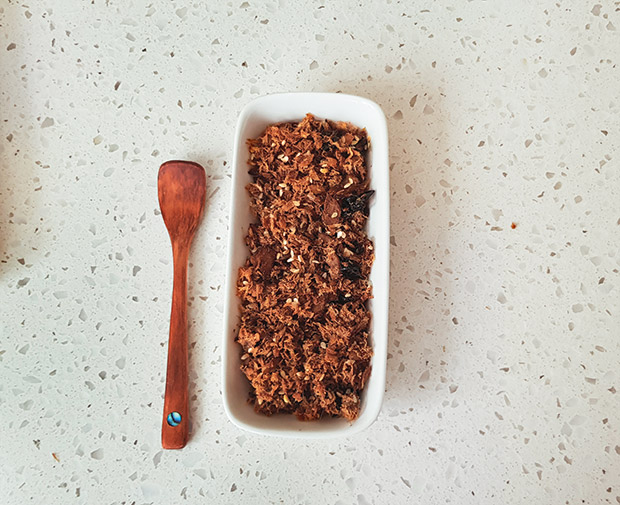
INGREDIENTS
1 salmon fillet
2 tsp cooking oil
1 tbsp salt-reduced soy sauce
1 tbsp cooking sake or rice wine
1 tbsp toasted sesame seeds
1 tbsp dried bonito flakes
½ tsp kelp powder
1 sheet yaki nori, finely shredded
METHOD
Bake or grill the salmon in the oven until cooked through, then crush into small flakes with a fork.
Add oil to the frying pan and heat until medium-high. Add salmon flakes, soy sauce, and sake. Stir-fry until crisp. Allow salmon flakes to cool completely.
When cool, mix salmon with remaining ingredients and use immediately, or within a couple of days. Store in the fridge.
Jane’s tips:
• I collect and store cumin and coriander seeds from my garden. I crush them just before I use them.
• I prefer to dry my homegrown parsley, as the boxed stuff doesn’t have much flavour.
• Shop-bought garlic powder seems to last a short time, then sticks together. I dry peeled garlic cloves in a food dehydrator and store
them in an airtight container, then powder them just before use.
4. Shichimi Togarashi
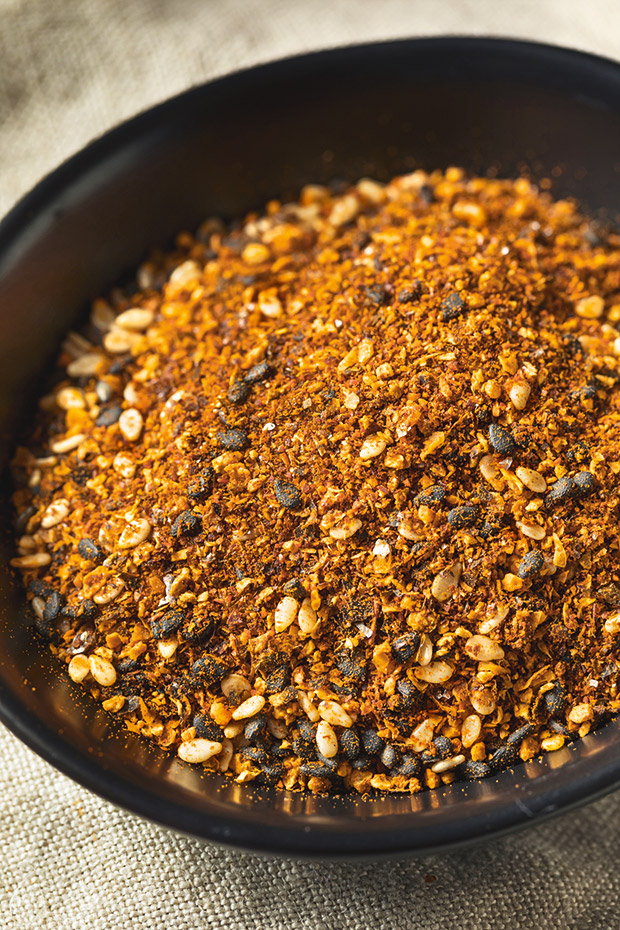
This Japanese seven-spice blend typically includes sesame seeds, poppy seeds, dried chilli peppers, ground ginger, pepper, dried nori, and a surprise ingredient, dried orange peel.
Shichimi togarashi (pronounced shee-CHEE-mee TOW-gar-rah-she) usually includes two hot and two aromatic spices (or flavours). You can swap ingredients depending on your taste. For example, instead of white pepper, you can use Sichuan peppercorns or sansho pepper (a pungent Japanese green pepper). You could replace the sesame seeds for shiso seeds (if you grow shiso, you can collect the seeds).
This versatile spicy blend adds flavour to soups, meat, seafood, and noodles.
Tips:
• You can buy orange peel powder from brew shops and some Asian food stores. I use homegrown blood oranges. Dry the peel in a dehydrator, then crumb it in a food processor.
• If you make it in bulk, store it in an airtight container in a dark place. It will last about 2 months – replace when the colour fades. Sniff it too, as the sesame seeds will go rancid.
INGREDIENTS
1 tbsp dried crumbed orange peel
2 tsp toasted sesame seeds
1 tsp poppy seeds
1 tsp ground ginger
¼ tsp white pepper
¼ tsp chilli flakes (less or more for taste)
1 sheet yaki nori, finely shredded
METHOD
Mix everything together. Stores for 2 months in an airtight container in a dark place.
Bonus: Mixed Pickles
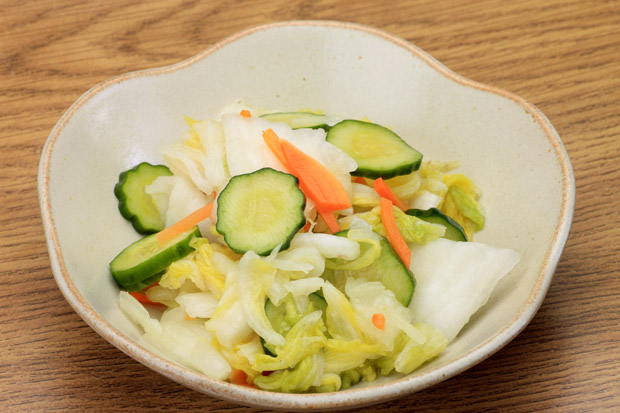
Pickles aren’t a spice, but they are an important side dish in Japanese cuisine, served at most meals with rice and miso soup. You can pickle whatever you have growing, but in Japanese cuisine it’s usually carrot, daikon radish, and cabbage.
Makes: 2 cups
Time: 45 minutes (not including chilling time)
INGREDIENTS
150g cabbage
100g daikon radish
1 carrot
½ cucumber, cut in half and seeds scooped out
6 cloves garlic, finely sliced
1 tbsp salt
1 small lemon, sliced
1 cup rice vinegar
1 cup sugar
METHOD
Cut the cabbage, radish, carrot, and cucumber into small, thin strips. Place vegetables in a colander, add the garlic, sprinkle with salt, then toss to mix. Set aside for 30 minutes. Rinse under cold water, then add lemon slices on top.
Heat rice vinegar and sugar in a saucepan with 60ml of water. Bring to the boil, stirring until the sugar has dissolved. Simmer for 5 minutes, then remove from the heat. Leave to cool.
Put the vegetables and lemon slices in a large jar. Pour over the cooled vinegar-sugar mix, cover, and refrigerate for at least 24 hours before use. These pickles will keep for about a month in the fridge.
HOW TO GROW SHISO
Shiso is a herb from the mint family. The leaves of the green variety taste of a mix of mint, coriander, basil, and anise, with a hint of citrus. Add fresh raw leaves to salads, and dry, crushed seeds to spice mixes.
Purple shiso is mostly used in pickles to add colour and flavour. It’s not usually eaten raw unless grown as a microgreen, as the mature leaves are very bitter.
Shiso can take a while to germinate. Seeds need to be cold stratified (chilled at 5°C for 7 days) before you plant them. Protect from frosts, and from birds which also love the taste.


